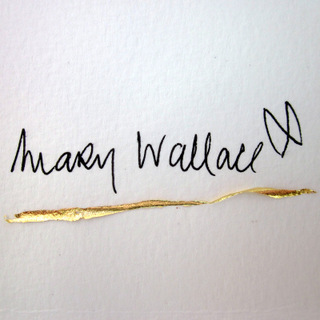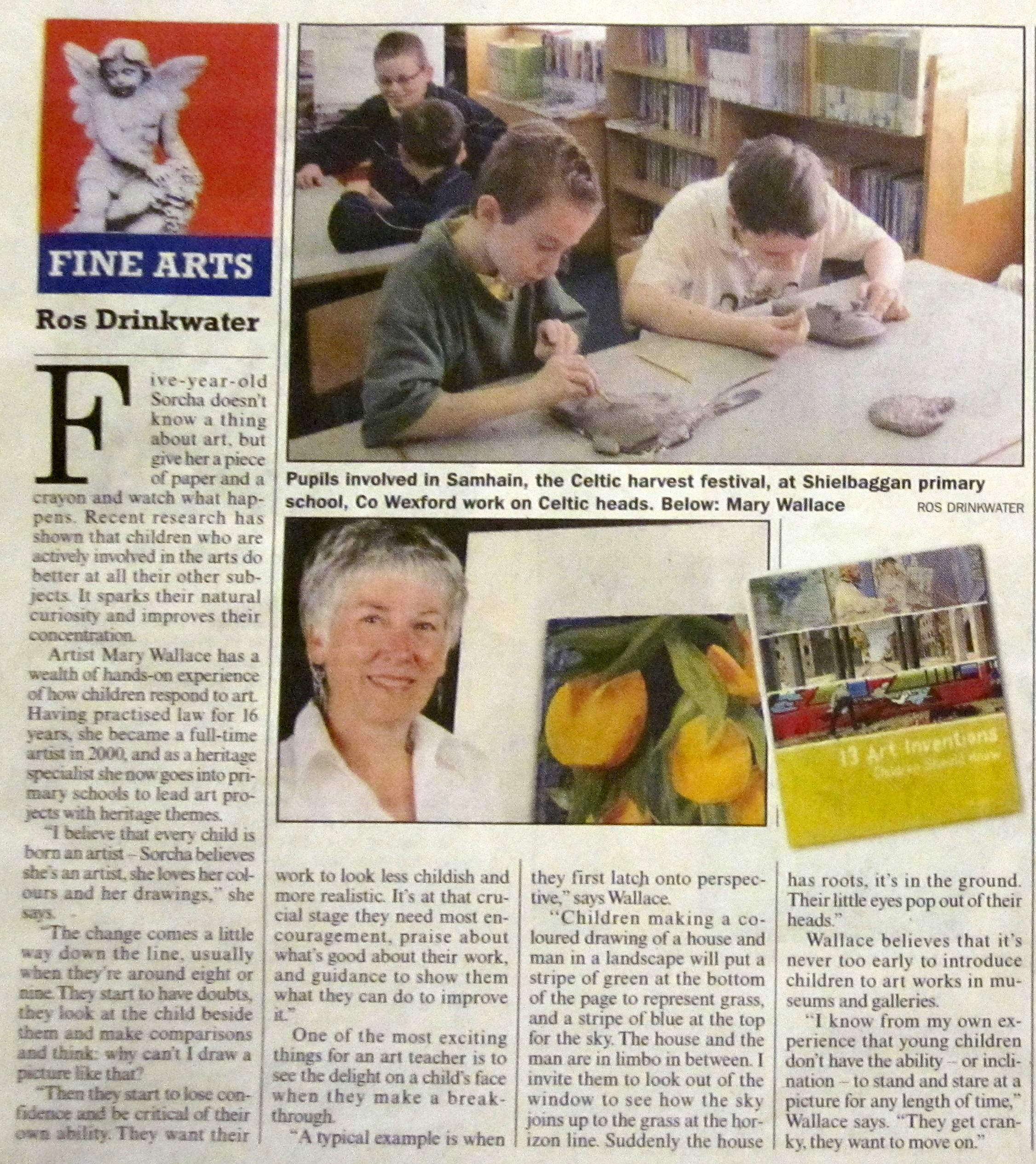Getting to the Art of Education
A recent encounter reminded me of this piece written by Ros Drinkwater eleven years ago and I felt compelled to plant it here so that I would always be able to put my hand to it. Initially Ros got in touch with me to discuss a book she had been asked to review and to pick my brain about children and their interest in art. It was meant to be a book review.... but in the end the book didn't even get a mention!

Getting to the Art of Education
Ros Drinkwater, Fine Art Correspondent
Sunday Business Post 30/10/2011
Five-year-old Sorcha doesn't know anything about art, but give her a piece of paper and a crayon and watch what happens. Recent research has shown that children who are actively involved in the Arts do better at all the other subjects. It sparks their natural curiosity and improves their concentration.
Artist Mary Wallace has a wealth of hands-on experience of how children respond to art. Having practiced law for 16 years, she became a full-time artist in 2000, and as a heritage specialist she now goes into primary schools to lead art projects with heritage themes.
“I believe that every child is born an artist. Sorcha believes she's an artist. She loves her colours and her drawings” she says. “The change comes a little way down the line usually when they're around 8 or 9. They start to have doubts. They look at the child beside them and make comparisons and think: why can't I draw a picture like that?”
“Then they start to lose confidence and be critical of their own ability. They want their work to look less childish and more realistic. It's at that crucial stage they need most encouragement, praise about what's good about their work, and guidance to show them what they can do to improve it.
“One of the most exciting things for an art teacher is to see the light on a child's face when they make a breakthrough. A typical example is when they first latch onto perspective, “says Wallace.
“Children making a coloured drawing of a house and a man in the landscape will put a stripe of green at the bottom of the page to represent grass and stripe of blue at the top for the sky. The house and the man are in limbo in between. I invite them to look out of the window to see how the sky joins up to the grass on the horizon line. Suddenly the house has roots, it's in the ground. Their little eyes pop out of their heads.”
Wallace believes that it's never too late to introduce children to art works in museums and galleries.
“I know from my own experience that young children don't have the ability - or inclination - to stand and stare at picture for any length of time. “ Wallace says. “ They get crankly. They want to move on. Her advise is that they should persevere.
“Rather than taking them right around the gallery, it's a good idea to visit one or two particular paintings or sculptures, perhaps something they can research before the visit” she says. “It is important to nurture your child's interests early, but don't force it on them, let it come gently.”
Wallace's heritage work is extremely varied, as every class and every project is unique.
“The idea is that they develop their knowledge through making art,” she says. “The subject is usually something the children have researched - legends , the seasons, local history, such as the 1798 rebellion. We did one recently on thatched cottages which the class constructed from fabric and fibre.”
Her latest project is Samhain, the Celtic harvest festival at the Shielbaggan Primary School in County Wexford.
“The focus was on Celtic rather than ghosts and pumpkins,” she says. “The children initially made drawings – their ideas of how a Celtic God might have looked - before going on to make clay figures. For that they started with the basics, learning how to make a pinch pot, the simplest things you can make with clay. Over the ten weeks they learned a great many skills culminating in the clay head.”
Wallace believes passionately that every school should have a dedicated art teacher.
“We must nurture creative thought,” she says. “So much of our current education program is learning by rote – I can see that's important, children have to learn their tables - but we must encourage individuals to have ideas and to realise that there is more than one right answer.”
“When they arrive in the workplace, they'll need the confidence to find new solutions, new ways of thinking. People talk about creative thinking in the business world, but unless you've had that experience when you're young, how will you, ten years down the line, be able to talk about that strange funny idea you have in your head? Art in education and learning through creative activity is vital.”


Getting to the Art of Education
Ros Drinkwater, Fine Art Correspondent
Sunday Business Post 30/10/2011
Five-year-old Sorcha doesn't know anything about art, but give her a piece of paper and a crayon and watch what happens. Recent research has shown that children who are actively involved in the Arts do better at all the other subjects. It sparks their natural curiosity and improves their concentration.
Artist Mary Wallace has a wealth of hands-on experience of how children respond to art. Having practiced law for 16 years, she became a full-time artist in 2000, and as a heritage specialist she now goes into primary schools to lead art projects with heritage themes.
“I believe that every child is born an artist. Sorcha believes she's an artist. She loves her colours and her drawings” she says. “The change comes a little way down the line usually when they're around 8 or 9. They start to have doubts. They look at the child beside them and make comparisons and think: why can't I draw a picture like that?”
“Then they start to lose confidence and be critical of their own ability. They want their work to look less childish and more realistic. It's at that crucial stage they need most encouragement, praise about what's good about their work, and guidance to show them what they can do to improve it.
“One of the most exciting things for an art teacher is to see the light on a child's face when they make a breakthrough. A typical example is when they first latch onto perspective, “says Wallace.
“Children making a coloured drawing of a house and a man in the landscape will put a stripe of green at the bottom of the page to represent grass and stripe of blue at the top for the sky. The house and the man are in limbo in between. I invite them to look out of the window to see how the sky joins up to the grass on the horizon line. Suddenly the house has roots, it's in the ground. Their little eyes pop out of their heads.”
Wallace believes that it's never too late to introduce children to art works in museums and galleries.
“I know from my own experience that young children don't have the ability - or inclination - to stand and stare at picture for any length of time. “ Wallace says. “ They get crankly. They want to move on. Her advise is that they should persevere.
“Rather than taking them right around the gallery, it's a good idea to visit one or two particular paintings or sculptures, perhaps something they can research before the visit” she says. “It is important to nurture your child's interests early, but don't force it on them, let it come gently.”
Wallace's heritage work is extremely varied, as every class and every project is unique.
“The idea is that they develop their knowledge through making art,” she says. “The subject is usually something the children have researched - legends , the seasons, local history, such as the 1798 rebellion. We did one recently on thatched cottages which the class constructed from fabric and fibre.”
Her latest project is Samhain, the Celtic harvest festival at the Shielbaggan Primary School in County Wexford.
“The focus was on Celtic rather than ghosts and pumpkins,” she says. “The children initially made drawings – their ideas of how a Celtic God might have looked - before going on to make clay figures. For that they started with the basics, learning how to make a pinch pot, the simplest things you can make with clay. Over the ten weeks they learned a great many skills culminating in the clay head.”
Wallace believes passionately that every school should have a dedicated art teacher.
“We must nurture creative thought,” she says. “So much of our current education program is learning by rote – I can see that's important, children have to learn their tables - but we must encourage individuals to have ideas and to realise that there is more than one right answer.”
“When they arrive in the workplace, they'll need the confidence to find new solutions, new ways of thinking. People talk about creative thinking in the business world, but unless you've had that experience when you're young, how will you, ten years down the line, be able to talk about that strange funny idea you have in your head? Art in education and learning through creative activity is vital.”


